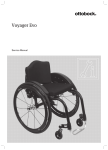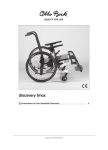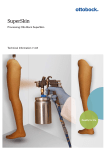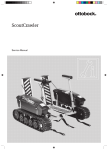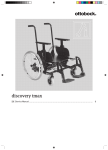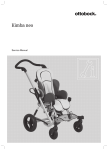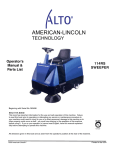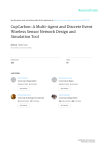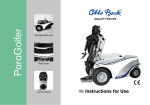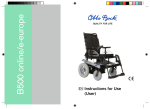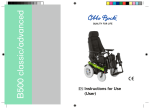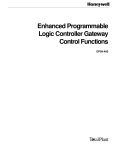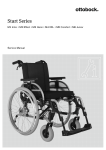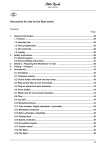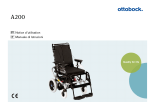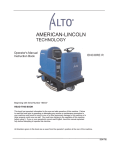Download Voyager Evo - Ottobockdoc.se
Transcript
Voyager Evo Instructions for Use (Qualified Personnel) ............................................................... 3 2 | Ottobock Voyager Evo Table of contents Table of contents 1 Foreword ..............................................................................................................................................................5 2 2.1 2.2 2.3 2.4 Application ...........................................................................................................................................................5 Intended Use .......................................................................................................................................5 Indications ...........................................................................................................................................5 Contraindications .................................................................................................................................5 Necessary qualifications ........................................................................................................................6 3 3.1 3.2 3.3 3.4 Safety ....................................................................................................................................................................6 Explanation of Warning Symbols .............................................................................................................6 General safety instructions .....................................................................................................................6 Safety instructions for assembly ..............................................................................................................6 Name Plate ..........................................................................................................................................7 4 4.1 4.2 4.3 Delivery .................................................................................................................................................................7 Scope of Delivery ..................................................................................................................................7 Options ...............................................................................................................................................7 Storage ...............................................................................................................................................7 5 5.1 5.2 Preparation for Use ............................................................................................................................................8 Tools required ......................................................................................................................................8 Assembly .............................................................................................................................................8 6 6.1 6.2 6.2.1 6.2.1.1 6.2.2 6.2.3 6.2.3.1 6.2.4 6.3 6.3.1 6.3.2 6.4 6.4.1 6.5 6.5.1 6.5.2 6.6 6.6.1 6.6.2 6.7 6.7.1 6.7.2 6.8 6.8.1 6.9 6.9.1 6.9.2 6.9.3 6.9.4 Adjustments .........................................................................................................................................................9 Prerequisites ........................................................................................................................................9 Adjusting the Rear Wheels .....................................................................................................................9 Adjusting the Horizontal Position of the Rear Wheels .............................................................................10 Adjusting the Rear Wheel Axle ..............................................................................................................10 Adjusting the track width (additional adjustment).....................................................................................11 Adjusting the rear wheel camber ...........................................................................................................12 Adjusting the 0°/3°/6° Rear Wheel Camber ............................................................................................12 Adjusting the track ..............................................................................................................................13 Adjusting the Caster Wheels ................................................................................................................13 Adjusting the Caster Wheel Journal Angle ..............................................................................................13 Changing the Installation Position of the Caster Wheels ..........................................................................14 Adjusting the Brakes ...........................................................................................................................15 Adjusting the Wheel Locks ...................................................................................................................15 Adjustment of the backrest ...................................................................................................................16 Adjusting the backrest height ...............................................................................................................16 Adjusting the Back Angle .....................................................................................................................16 Adjusting the Back/Seat Upholstery ......................................................................................................17 Adjusting the Back Upholstery ..............................................................................................................17 Adjusting the Seat Upholstery ...............................................................................................................18 Adjusting the footrests .........................................................................................................................19 Adjusting the lower leg length ...............................................................................................................19 Adjusting the plate angle ......................................................................................................................19 Adjustment of the side panels ...............................................................................................................20 Adjusting the "Standard" and "Clothing Protector" Side Panels................................................................20 Installing / adjusting the anti-tipper and tip-assist ....................................................................................21 Installing the Accessory Mount .............................................................................................................21 Installing the anti-tipper........................................................................................................................21 Adjusting the Anti-Tipper ......................................................................................................................21 Installing / adjusting the tip-assist..........................................................................................................22 7 7.1 7.2 7.3 Handover ............................................................................................................................................................22 Final inspection ..................................................................................................................................22 Transport to the customer ....................................................................................................................22 Handover ...........................................................................................................................................22 Voyager Evo Ottobock | 3 Table of contents 8 Maintenance/Repair .........................................................................................................................................23 9 9.1 9.2 Disposal .............................................................................................................................................................23 Disposal information ............................................................................................................................23 Information on re-use ...........................................................................................................................23 10 10.1 10.2 10.3 10.4 Legal Information ..............................................................................................................................................23 Liability ..............................................................................................................................................23 CE Conformity ....................................................................................................................................23 Warranty ............................................................................................................................................23 Trademarks ........................................................................................................................................23 11 Technical Data ...................................................................................................................................................24 4 | Ottobock Voyager Evo Foreword 1 Foreword INFORMATION Date of the last update: 2014-05-07 ► Please read this document carefully. ► Follow the safety instructions. INFORMATION ► You can request this document as a PDF file from the Customer Care Center (CCC) at [email protected] or from the manufacturer's service department (see inside back cover or back page for addresses). ► It is possible to increase the display size of the PDF document. Initial adjustments to the product were made according to the order form. Nevertheless, fine adjustment may be required and settings may have to be made according to the medical conditions or the user's requirements. These instructions for use provide the information necessary for adjusting the settings. This work should be closely coordinated with the user. Please note the following: • The instructions for use (qualified personnel) are intended only for qualified personnel and remain with them. • The operation of the product and functionality of the options are described in the instructions for use (user). These instructions for use must be given to the user. • Children and youths must be instructed in the use of the product by you or an attendant using the instructions for use (user). • The manufacturer recommends checking the product settings regularly in order to assure an optimum fit over the long term. A review is required every six months for children and youths in particular. • The installation and retrofitting of all optional components are generally described in the service manual. 2 Application 2.1 Intended Use The manual wheelchair for active use is designed solely for individual use by persons who are unable to walk or who have a walking impediment and can be operated either by the patient or by another person. The manual wheelchair for active use may only be combined with the options listed in these instructions for use. Ottobock assumes no liability for combinations with medical devices and/or accessories from other manufacturers outside of the modular system. 2.2 Indications The broad range of equipment options and the modular design allow the wheelchair to be used by people who are unable to walk or have a walking impediment, for example due to: • Paralysis (paraplegia, tetraplegia) • Loss of limbs (leg amputation) • Defects or deformation of the limbs • Joint contractures or damage • Neurological and muscular diseases • Disorders such as cardiac or circulatory insufficiency, equilibrium disturbances or cachexia as well as geriatric patients who still have usable residual strength in the upper limbs. The wheelchair was designed in particular for individuals who are generally able to move around actively and freely in the wheelchair. 2.3 Contraindications In view of the wide variety of setting options (e.g. active/passive settings), this wheelchair type is suitable for all user groups. In certain versions and with certain settings, however, the wheelchair tends to tip backwards due to its design. This is an intentional feature designed to enable users with the corresponding physical prerequisites to manoeuvre quickly and nimbly. Users lacking the necessary physical or psychological prerequisites must not be supplied with such versions/settings. Due to its dimensions, this wheelchair type should not be used for small children. Voyager Evo Ottobock | 5 Safety 2.4 Necessary qualifications The installation and adjustments described below may only be carried out by qualified personnel. 3 Safety 3.1 Explanation of Warning Symbols WARNING Warnings regarding possible risks of severe accident or injury. CAUTION Warnings regarding possible risks of accident or injury. NOTICE Warnings regarding possible technical damage. 3.2 General safety instructions WARNING Lack of instruction Risk of falling, tipping over due to lack of knowledge ► Instruct the user or the attendant in the proper use of the product when handing it over. CAUTION Use of unsuitable tools Pinching, crushing or damaging the product ► When working, use only tools that are suitable for the conditions at the workplace and whose proper use ensures safety and health protection. NOTICE Tipping or falling of the product Damage to the product ► When you work on the product, secure it so that it cannot tip over or fall over. ► Use a clamping device to secure the product for all work at a workbench. NOTICE Use of unsuitable packaging Damage caused by transport in the wrong packaging ► Use only the original packaging for delivery of the product. 3.3 Safety instructions for assembly CAUTION Incorrect fitting of the rear wheels Risk of falling or tipping due to wheels coming loose ► After every assembly, check the proper mounting of the rear wheels. The wheel axles must be securely locked in the fitting. CAUTION Modified diameters/mounting positions of the wheels Risk of falling of tipping of the user due to locking wheels ► Modification of the size and position of the front wheels and of the rear wheel size can lead to wobbling of the front wheels at higher speeds. If modification is necessary, ensure proper horizontal alignment of the wheel chair frame (see chapter "Adjustment of the rear wheel", "Adjustment of the front wheel"). 6 | Ottobock Voyager Evo Delivery CAUTION Incorrect installation of the anti-tipper/missing anti-tipper Risk of the user tipping to the rear ► Depending upon the settings of the chassis, the centre of gravity, the back angle and the experience of the user, the use of an anti-tipper may be necessary. ► For a small wheelbase and a backrest that is tilted far back, an anti-tipper may need to be installed on both sides, depending upon the user's experience. ► Verify that the anti-tipper has been installed and adjusted properly. Find the appropriate position with the assistance of a helper. 3.4 Name Plate Label A B C D E F G The nameplate can be found on the rigid H axle. I Meaning Type designation Manufacturer article number Maximum load capacity (see chapter "Technical data") Manufacturer information, address, country of origin Serial number/manufacturing date European Article Number/Global Trade Item Number Read the instructions for use before using the product. CE marking – product safety according to EU guidelines The product has not been approved by the manufacturer for use as a seat in a wheelchair accessible vehicle See the instructions for use (user) for additional warning labels 4 Delivery 4.1 Scope of Delivery The wheelchair is delivered preassembled and with the side panels/rear wheels removed and packed in a crate. The scope of delivery includes: • Preassembled wheelchair • 2 side panels • 2 rear wheels • Options according to the order • Instructions for use (qualified personnel), instructions for use (user). INFORMATION Only provide the instructions for use (user) to the user. Seat cushions are not included and must be ordered separately. 4.2 Options The functionality and operation of the options are described in more detail in the instructions for use (user). All of the available options/accessories are listed on the order form. 4.3 Storage The wheelchair must be stored in a dry place. The ambient temperature must be maintained between -10 °C and +40 °C during transportation and storage. During extended storage, the knee lever wheel lock on wheelchairs with PU tyres must be released since tyre deformation may otherwise result. INFORMATION Tyres contain chemical substances that can react with other chemical substances (such as cleaning agents, acids, etc.). Voyager Evo Ottobock | 7 Preparation for Use 5 Preparation for Use 5.1 Tools required The following tools are required to make fine adjustments/settings: • Allen keys in sizes 3, 4, 5 mm • Ring and open-ended wrenches in sizes 10, 11, 16, 19 and 20 • Torque wrench (measurement range 5-50 Nm) • Measurement equipment: yardstick, spirit level, back square • Liquid thread locker, "medium" and "strong" 5.2 Assembly CAUTION Exposed pinch points Risk of crushing or pinching the fingers due to incorrect handling ► When folding out the backrest, only grip by the specified components. CAUTION Incorrect fitting of the rear wheels Risk of falling or tipping due to wheels coming loose ► After every assembly, check the proper mounting of the rear wheels. The wheel axles must be securely locked in the fitting. INFORMATION For details of weights of the individual parts, see section "Technical Data". 1) Push the rear wheels into the wheel brackets. The quick-release axles must not be able to be removed after the pushbutton has been released. 2) Pull the backrest cable until the locking mechanism releases (see Fig. 1). Position the backrest upright and allow it to engage. Do not reach into the locking mechanism while doing so. 3) Insert the side panels in the side panel mountings. In doing so, ensure that the mounting plate is up against the side panel from the outside (see Fig. 2). 4) If necessary: Insert the calf strap. 5) Fit the seat cushion on the hook-and-loop material. 1 8 | Ottobock 2 Voyager Evo Adjustments 6 Adjustments 6.1 Prerequisites WARNING Incorrect settings Risk of falling, tipping over or improper user posture due to incorrect settings ► Adjustments may be carried out only by qualified personnel. ► Only the settings described in these instructions for use may be carried out. ► Settings may only be changed within the allowable adjustment ranges; otherwise, the stability of the product may be impaired (see this chapter and the chapter "Appendixes"). If you have questions, contact the manu facturer's service (see back cover for addresses). ► Only conduct tests in the presence of an assistant. ► Unless expressly described, you may not change any settings with a person sitting in the product. ► Secure the user against falling out during all tests. ► Before testing setting changes with the user seated, firmly tighten all screw connections. ► Check for safe function before delivering the product. CAUTION Unsecured screw connections Risk of pinching, crushing, tipping over, falling of user ► After all adjusting/readjusting work, retighten the mounting screws/nuts firmly. Observe any torque settings which may be specified. ► Any time you loosen a screw connection with thread lock, replace it with a new screw connection or secure the old screw connection with medium strength thread locker (e.g. Loctite® 241). CAUTION Improper use of self-locking nuts Risk of the user falling or tipping over ► Always replace self-locking nuts with new self-locking nuts after disassembly. Fine adjustments and setting changes to match the concrete physical and mental condition of the user should always be made in the user's presence. All parts of the product should be cleaned thoroughly before adjustments are made. 6.2 Adjusting the Rear Wheels CAUTION Lack of fine adjustment of the rear wheel Risk of falling or tipping of the user ► Check the standard adjustments of the wheelchair for stability against tipping and function of the rear wheels. Avoid any extreme settings. CAUTION Incorrectly adjusted wheelbase Risk of falling or tipping of the user ► Please note that with the rear wheel in the front position and with an unfavourable body position, the user may tip backwards even on level ground. ► Use an anti-tipper for inexperienced users and with extreme settings of the rear wheel. ► Be sure to position the rear wheels towards the rear for transfemoral amputees. That improves the stability of the wheelchair. Voyager Evo Ottobock | 9 Adjustments CAUTION Incorrect mounting of the camber module Falling, tipping over of the user due to lack of adhesion ► Do not pull the camber module out too far. During installation the whole camber module must be fully enclosed by the clamping fixture. INFORMATION Changing the rear wheel position can also change the angle between the front caster head and the ground. However, this must be approx. 90°. The knee lever wheel lock also has to be readjusted. 6.2.1 Adjusting the Horizontal Position of the Rear Wheels The horizontal rear wheel position can be changed by sliding the axle assembly horizontally on the seat tubes. Changing the rear wheel position has the following effects: Position of rear wheel Move to rear Effects • Larger wheelbase • Larger turning circle • Greater stability of the wheelchair • Wheelchair is harder to tip backwards when crossing obstacles • Position recommended for inexperienced users Move forwards • • • • • Smaller wheelbase Less load on castor wheels = greater manoeuvrability Less stability of the wheelchair Wheelchair is easier to tip backwards when crossing obstacles NOTE: An anti-tipper can be installed if necessary. Position recommended only for experienced users 6.2.1.1 Adjusting the Rear Wheel Axle The axle assembly is continuously adjustable horizontally on the seat tubes. 1) Remove the wheels. 2) Pull the side panels out of the guides on the side panel mountings. 3) Loosen the connection between the seat plate or seat upholstery and the seat tube clamps: → With a seat plate: Loosen the Allen head screws between the seat plate and seat tube clamps (see Fig. 3, item 1). → With seat upholstery: Loosen all Allen head screws between the seat upholstery and seat tube clamps (see Fig. 4, item 1). Remove the seat upholstery. 4) Loosen the Allen head screws respectively between the seat tube clamps and seat tubes (see Fig. 3, item 2). 5) Move the axle assembly to the desired position (see Fig. 5). 6) Ensure that the depth setting is the same. For fine-tuning, measure the distance respectively between the centre of the axle tube and the centre of the lower screw on the back bracket (see Fig. 6). 7) Tighten the Allen head screws between the seat tube clamps and seat tubes to 15 Nm (see Fig. 3, item 2). 8) Reconnect the seat plate or seat upholstery and the seat tube clamps: → With a seat plate: Tighten the Allen head screws between the seat plate and seat tube clamps to 8 Nm (see Fig. 3, item 1). → With seat upholstery: At the height of the adjusted seat tube clamps, punch the seat upholstery with a 6 mm hole punch and drill 6 mm holes in the upholstery tube. Tighten the Allen head screws between the seat upholstery and seat tube clamps to 8 Nm (see Fig. 4, item 1). 9) Slide the side panels back into the side panel mountings. Adjust the side panels if necessary (see Page 20). INFORMATION Following adjustment the track of the rear wheel, the castor journal angle and the knee lever wheel lock must be checked and, if necessary, readjusted (refer to the corresponding section). 10 | Ottobock Voyager Evo Adjustments 3 4 5 6 6.2.2 Adjusting the track width (additional adjustment) The camber modules can slide in the axle for adjusting the track width horizontally (see Fig. 7, item 1) . In case of camber modules with a screwed-in fitting, the counter nut on the fitting also has to be loosened and the fitting adjusted to the desired length. Adjustment on camber module for quick-release axles Ø 12 mm 1) Remove the wheels. 2) Loosen the Allen head screw respectively on the seat clamp (see Fig. 8). 3) Loosen the Allen head screw respectively on the axle tube clamp (see Fig. 9). NOTE: The adjustment should be made on one side first and then on the other. NOTE: The track width must be adjusted symmetrically on both sides. Set the track width so that the slanted rear wheels run freely. 4) Insert the rear wheel's quick-release axle into the camber module to aid removal (see Fig. 10). 5) Move the camber module to the desired position outwards with the aid of the quick-release axle or inwards with the help of a soft-faced hammer. → Do not pull the camber module out too far. During installation the whole camber module must be fully enclosed by the axle tube clamp. → Check the position by measuring it afterwards. To do this, measure the distance between the outer side of the camber module and the outer side of the axle tube clamp. 6) Lightly clamp the camber module in the axle tube clamp. 7) Adjust the track width in the same fashion on the other side. Make sure that both camber modules have been adjusted symmetrically. 8) Make the track adjustments (see Page 13). 9) Tighten the Allen head screw respectively on the axle tube clamps to 15 Nm (see Fig. 9). 10) Tighten the Allen head screw respectively on the seat clamps to 7 Nm (see Fig. 8). Voyager Evo Ottobock | 11 Adjustments 7 8 9 10 6.2.3 Adjusting the rear wheel camber The rear wheel camber is adjusted by exchanging of the camber modules. This has the following effects: Position of rear wheel Wheel camber 3°/6° Effects • Wheelchair becomes more manoeuvrable, turns faster and tips less easily to the side • Overall width increases • Increased rolling resistance 0° position • • Narrow track, excellent straight-line stability Low rolling resistance 6.2.3.1 Adjusting the 0°/3°/6° Rear Wheel Camber The modular system of the product offers camber options for different sloped settings of the rear wheels (example: see Fig. 11). 1) Remove the wheels. 2) Remove the camber modules (see Page 11). INFORMATION: Make sure that the same camber module is installed on both sides. 3) Exchange and install the camber modules (see Page 11). → Set the track width so that the slanted rear wheels run freely. → During installation the whole camber module must be fully enclosed by the axle tube clamp. → Check the position by measuring it afterwards. 4) Lightly clamp the camber module in the axle tube clamp. 5) Adjust the track width in the same fashion on the other side. Make sure that both camber modules have been adjusted symmetrically. 6) Adjust the track (see Page 13). Use an adjustment aid (e.g. back square) to do so. 7) Tighten the Allen head screw respectively on the axle tube clamps to 15 Nm (see Fig. 9). 8) Tighten the Allen head screw respectively on the seat clamps to 7 Nm (see Fig. 8). 12 | Ottobock Voyager Evo Adjustments 11 6.2.4 Adjusting the track INFORMATION The track must be adjusted after the following adjustments have been made: Adjusting the track width: see Page 11 Adjusting the rear wheel camber: see Page 12 The track setting must be checked and, if necessary, adjusted after the following adjustments have been made: → Adjusting the horizontal position of the rear wheel: see Page 10 ► → → ► INFORMATION ► When adjusting the rear wheel track, always check the symmetry of the track width setting. To do this, meas ure the distance between the outer side of the camber module and the outer side of the axle tube clamp. ► The caster wheel journal angle should be checked immediately after every adjustment to the track (see Page 13 et seq.). 1) Loosen the seat clamps (see Fig. 8) and axle tube clamps (see Fig. 9) so that the camber modules are only lightly clamped in the rear wheel axle (see Page 11). 2) Place the wheelchair on an even surface. Avoid twisting the axle when doing this. 3) Pull the rear wheel out slightly in order to make room for the installation. 4) A 90° back square placed on a level surface is used as an adjustment aid. 5) Carefully turn the camber module until the spanner flat is flush with the blade of the back square. The spanner flat of the camber module is now vertical (see Fig. 7, item 2). 6) Tighten the Allen head screw respectively on the axle tube clamps to 15 Nm (see Fig. 9). 7) Tighten the Allen head screw respectively on the seat clamps to 7 Nm (see Fig. 8). 6.3 Adjusting the Caster Wheels 6.3.1 Adjusting the Caster Wheel Journal Angle When the rear wheels have been adjusted for the user, the caster wheel journal angle must be adjusted if needed. The caster wheel axles/caster wheels must be perpendicular to the ground to ensure optimum wheelchair driving characteristics (see Fig. 12). 1) If necessary: Heat the plug guide (see Fig. 15, right) with hot air (~ 80 °C) to soften the Loctite. 2) Loosen the clamping on the plug guide. In order to do so, remove the M8 Allen head screw on the inside while it is hot (see Fig. 13, item 1). 3) Loosen the bearing sleeve: → Loosen the set screw on the outside (see Fig. 13, item 2; see Fig. 14). → Remove the bearing sleeve (not illustrated). 4) Instead of the bearing sleeve, slide a suitable lever tube into the caster wheel journal (see Fig. 15, item 1). 5) Pry the caster wheel journal (see Fig. 15, item 2) secured with Loctite out of the taper fitting (see Fig. 15, item 3). 6) Remove the remaining Loctite from the surfaces and threads of the disassembled components (not illustrated). Apply new "high strength" Loctite. INFORMATION: Note that only approx. 5–7 min. is available for the subsequent steps 7–9. Voyager Evo Ottobock | 13 Adjustments 7) Temporarily attach the bearing sleeve with caster fork in the caster wheel journal. 8) Set the caster wheel axle vertically. Check the 90° setting with a square (see Fig. 12). → The caster wheel axles/caster wheels on both caster wheel adapters must be positioned vertically. 9) Reinstall the caster wheel assembly. When tightening the screws, note the following torque values: → Allen head screw on the inside (see Fig. 13, item 1): 23 Nm → Set screw (secured with "medium" Loctite) on the outside to secure the bearing sleeve (see Fig. 13, item 2): 8 Nm 12 13 14 15 6.3.2 Changing the Installation Position of the Caster Wheels INFORMATION Observe the seat height table in the "Technical data". The front seat height can be adjusted by moving the caster wheels in the fork and by selecting the caster wheel size. 1) Unscrew the screw connection of the threaded axle (see Fig. 17). 2) Remove the threaded axle/spacers. 3) Remove the caster wheel. 4) Insert the threaded axle with the first spacer bushing offset in one of the bore holes. 5) Install the caster wheel. 6) Slide on the second spacer bushing (not illustrated). 7) Tighten the threaded axle to 8 Nm. → Once changed, the left and right caster wheel must have the same vertical position in the caster fork. → Once the anterior seat height has been adjusted, the rear wheel tracking (see Page 13) and the caster wheel journal angle (see Page 13) must be checked and adjusted if required. 14 | Ottobock Voyager Evo Adjustments 16 17 6.4 Adjusting the Brakes 6.4.1 Adjusting the Wheel Locks CAUTION Insufficient braking action of the knee lever wheel lock Risk of accidents, falling ► Check the air pressure of the rear wheels and the correct setting of the knee lever wheel lock. The correct tyre pressure is printed on the casing. For rear wheels, the minimum air pressure is 7 bar. ► Use only original rear wheels with an approved radial excursion of 1 mm maximum. Adjusting the knee lever wheel locks/scissor wheel locks This adjustment must be made after the rear wheel has been repositioned or during fine adjustment. 1) Loosen the Allen head screws in the clamp brackets (see Fig. 18, item 1). 2) Adjust/move the support for the knee lever wheel lock/scissor wheel lock to any position in the clamp bracket (knee lever wheel lock example: see Fig. 18, item 2). If necessary: Slide and twist the clamp bracket on the seat tube. 3) When the wheel lock is disengaged, the gap between the tyre and wheel lock bolt must not exceed 5 mm (see Fig. 19). INFORMATION: For special requirements when adjusting the scissor wheel lock, see the section "Special Requirements for Adjustments to the Scissor Wheel Locks". 4) Tighten the Allen head screws to 15 Nm. → After adjustment, the left and right knee lever wheel locks must both have the same braking force. 18 19 5 mm Special Requirements for Adjustments (All Types of Wheel Locks) Depending on the adjustment, it may be necessary to rotate or replace the support for the wheel lock. This makes further wheel lock adjustments possible. Voyager Evo Ottobock | 15 Adjustments Special Requirements for Adjustments to the Scissor Wheel Locks • Install the scissor wheel lock such that it can be guaranteed that the swivelling parts can move freely without colliding (see Fig. 20; see Fig. 21). • The scissor wheel lock should not hit the frame when it is open. • For information on using the scissor wheel lock, see the instructions for use (user), reference number 647G964. 20 21 6.5 Adjustment of the backrest 6.5.1 Adjusting the backrest height Adjustment of a Back Assembly with Back Plate The back height is continuously adjustable vertically by up to 25 mm. 1) On both sides, loosen all Allen head screws on the back plate (see Fig. 22). 2) Slide the back plate to the desired height. NOTE: Please note that the back angle can be adjusted now as well (see Fig. 23). 3) On both sides, tighten the Allen head screws to 8 Nm (see Fig. 22). Make sure that the right and left sides are parallel. Adjustment of a Back Assembly with Back Upholstery The back height cannot be changed afterwards. 22 6.5.2 Adjusting the Back Angle CAUTION Missing anti-tipper Risk of tipping of the user to the rear ► If the back is tilted far to the rear and in the case of a short wheelbase, 2 anti-tippers (one on each side) must be mounted and in a functional position; in the case of a long wheelbase, at least one anti-tipper must be mounted and in a functional position. ► Check that the anti-tipper is securely attached. 16 | Ottobock Voyager Evo Adjustments Adjustment of a Back Assembly with Back Plate The back angle is continuously adjustable by up to 15°. 1) On both sides, loosen all Allen head screws on the back plate (see Fig. 22). 2) Move the back plate to the desired angle (see Fig. 23). NOTE: Please note that the back height can now be adjusted as well (see Fig. 22). 3) On both sides, tighten the Allen head screws to 8 Nm (see Fig. 22). Adjustment of a Back Assembly with Back Upholstery The back height cannot be changed afterwards. 23 6.6 Adjusting the Back/Seat Upholstery 6.6.1 Adjusting the Back Upholstery INFORMATION A well-adjusted backrest provides lasting comfort for the wheelchair user and reduces the risk of secondary dam age and pressure zones. Do not create too much pressure. INFORMATION Ensure that the user's pelvis is positioned as far back in the wheelchair as possible, i.e. between the backrest tubes. The backrest cover can be adjusted in segments to the needs of the user. 1) Remove the seat cushion. 2) Fold the seat pad forwards away from the hook-and-loop fastener (not illustrated). 3) Pull the back padding up and off the hook-and-loop fastener on the back upholstery and remove it (see Fig. 24). 4) Loosen the backrest straps and then fasten together with the desired tension (see Fig. 25). 5) Fit the back padding and secure it with the hook-and-loop fastener to the back and seat upholstery: → Place the kink in the back padding at the top. The "V" in the padding (see Fig. 26, item 1) shows exactly where the kink is. → Pull the back padding flap tightly downwards. → Pull the part of the flap that can be fastened forwards and fasten tightly to the seat upholstery (see Fig. 27, item 1). INFORMATION: The part of the flap that can be fastened prevents sliding or falling through the gaps between the straps and protects against draughts. 6) Fasten the seat pad and the seat cushion. Voyager Evo Ottobock | 17 Adjustments 24 25 26 27 6.6.2 Adjusting the Seat Upholstery INFORMATION You can slightly correct the centre of gravity by making small changes to the sag of the seat upholstery. Larger corrections to the centre of gravity must be made by making changes to the settings on the frame, the axle unit and the caster wheels. The adaptable seat upholstery can be adjusted in segments to the needs of the user. 1) Remove the seat cushion. 2) Pull the seat pad off the hook-and-loop fastener (see Fig. 28). 3) Pull the flap of the backrest pad off the hook-and-loop fastener and let it hang down. 4) Loosen the backrest straps and then fasten together with the desired tension (see Fig. 29). 5) Secure the backrest pad to the seat upholstery with the hook-and-loop fastener. To do this, pull the part of the flap that can be fastened forwards and fasten to the seat upholstery (see Fig. 27). INFORMATION: The part of the flap that can be fastened prevents sliding or falling through the gaps between the straps and protects against draughts. 6) Secure the seat pad to the seat upholstery by means of the hook-and-loop fastener with edges aligned (see Fig. 28, item 1). 7) Secure the seat cushion with the hook-and-loop fastener. 18 | Ottobock Voyager Evo Adjustments 28 29 6.7 Adjusting the footrests 6.7.1 Adjusting the lower leg length The required footrest height depends on the lower leg length of the user and the thickness of the seat cushion. "Angle-adjustable" Footrest, "Fixed" Footrest 1) Loosen the Allen head screws above the footrest (see Fig. 30, item 1). 2) Adjust the lower leg length (continuously adjustable). The footrest must be inserted at least 60 mm into the frame tube. 3) Tighten the Allen head screws to 8 Nm. "Angle-adjustable/Depth-adjustable" Footrest The adjustment of this footrest can be fine-tuned as follows: 1) Loosen 2 Allen head screws respectively on each side of the footrest assembly. However, do not completely unscrew the Allen head screws (see Fig. 31, item 1). 2) After loosening the Allen head screws, pry the clamp washer out of the bore hole in the cross-tie using a suit able tool (e.g. screwdriver). Do not remove the clamp washer entirely. 3) Push the footrest assembly up/down slightly around the pivot point (see Fig. 31, item 2). Ensure that the crossties are parallel before re-tightening the screws. NOTE: During the adjustment process, never loosen the screws (see Fig. 31, Fig. 1 and Fig. 3) at the same time. 4) Tighten the Allen head screws to 10 Nm. In doing so, ensure that the clamp washer is parallel (not tilted) in the cross-tie for optimum fixation. INFORMATION: After each adjustment of the lower leg length, readjust the footrest angle. 30 31 6.7.2 Adjusting the plate angle The footrest setting should be chosen so that the ankle is in a relaxed, comfortable position. "Fixed" Footrest The angle of the footplate cannot be changed (not illustrated). Voyager Evo Ottobock | 19 Adjustments "Angle-adjustable" Footrest 1) Loosen the Allen head screws on the clamp bracket (see Fig. 32, item 1). 2) Rotate the footplate to the desired angle (see Fig. 32, item 2). 3) Tighten the Allen head screws to 10 Nm. "Angle-adjustable/Depth-adjustable" Footrest 1) Remove the protective caps from the screw connection (see Fig. 31, item 3). 2) Loosen the Allen head screws above the footplate (not illustrated). 3) Rotate the footplate to the desired angle (see Fig. 31, item 4). 4) Tighten the Allen head screws to 10 Nm. Reinstall the protective caps. 32 6.8 Adjustment of the side panels 6.8.1 Adjusting the "Standard" and "Clothing Protector" Side Panels After adjusting the rear wheel position or backrest, the position of the side panels needs to be checked and may have to be adapted. Adjusting the Side Panel Depth 1) Loosen the Allen head screws between the side panel and side panel bracket (see Fig. 33, item 1). 2) Adjust the side panel as needed. The side panels should be as close against the backrest as possible (see Fig. 33, item 2). 3) Tighten the Allen head screws to 8 Nm (see Fig. 33, item 1). Adjusting the Clothing Protector Lip 1) Loosen the Allen head screws between the side panel and clothing protector lip (see Fig. 33, item 3). 2) Adjust the clothing protector lip as needed. NOTE: Choose the setting so that the lip of the clothing protector is close enough to or far enough away from the tyre to exclude the risk of crushing. 3) Tighten the Allen head screws to 5 – 7 Nm (see Fig. 33, item 3). Adjusting the Side Panel Bracket The firm fit of the side panel can be influenced by slightly adjusting the Allen head screws (see Fig. 34). 20 | Ottobock Voyager Evo Adjustments 33 34 6.9 Installing / adjusting the anti-tipper and tip-assist CAUTION Incorrect installation of the anti-tipper/missing anti-tipper Risk of the user tipping to the rear ► Depending upon the settings of the chassis, the centre of gravity, the back angle and the experience of the user, the use of an anti-tipper may be necessary. ► For a small wheelbase and a backrest that is tilted far back, an anti-tipper may need to be installed on both sides, depending upon the user's experience. ► Verify that the anti-tipper has been installed and adjusted properly. Find the appropriate position with the assistance of a helper. 6.9.1 Installing the Accessory Mount The manufacturer offers an accessory mount for this product. This enables the installation of the anti-tipper and the tip-assist. A special axle tube clamp is also needed to install the accessory mount (see Fig. 35, item 1). The accessory mount and special axle tube clamp – depending on the order – are supplied already installed. It may be necessary to retrofit these components in the course of an initial fitting. To install these, see the 647G965 Service Manual. 6.9.2 Installing the anti-tipper Depending on the order, the anti-tipper (see Fig. 35, item 2) may already be installed when delivered. It may be necessary to retrofit or reposition the anti-tipper in the course of an initial fitting. To install and adjust this, see the 647G965 Service Manual. 35 36 6.9.3 Adjusting the Anti-Tipper INFORMATION In order to adjust the anti-tipper correctly, it may be necessary to combine the steps to adjust the length and angle. Voyager Evo Ottobock | 21 Handover Adjusting the Length of the Pivot Arm 1) Remove the Allen head screw on the pivot arm (see Fig. 37, item 1). 2) Adjust the length of the pivot arm. 3) Bolt down the pivot arm. The outer edge of the anti-tipper roller has to project beyond the largest diameter of the rear wheels (see Fig. 36). Adjusting the Angle of the Pivot Arm 1) Remove the Allen head screw between the anti-tipper tube and the angle adjuster (see Fig. 38, item 1). 2) Loosen the second Allen head screw on the angle adjuster (see Fig. 38, item 2). 3) Set the angle of the pivot arm. 4) Bolt down the pivot arm. The max. distance between the anti-tipper rollers and floor is 50 mm (see Fig. 36). 37 38 6.9.4 Installing / adjusting the tip-assist The tip-assist can be installed on the accessory mount in the installation position provided (see Fig. 35, item 1). 1) Press the spring on the tip-assist (not illustrated). 2) Insert the tip-assist into the accessory mount. 3) Allow the spring to lock in. 7 Handover 7.1 Final inspection A final check must be carried out before the wheelchair can be handed over: • Are all options installed according to the order form? • Have the rear wheels been correctly positioned? • Have the tyres been correctly inflated? NOTE: The correct air pressure is printed on the sidewall of the tyre. For rear wheels with high-pres sure tyres, the minimum air pressure is 7 bar. • Has the axle assembly been fastened to the frame and tightened to the specified torque? • Can the quick-release axles rotate freely? • Have the brakes (wheel locks) been adjusted correctly? • Has the caster journal angle been adjusted vertically? • Has the anti-tipper been adjusted correctly? 7.2 Transport to the customer The wheelchair should be transported to the user in disassembled state using the outer packaging. 7.3 Handover The following steps must be performed for the safe delivery of the product: • Conduct a sitting test with the user of the product. Pay special attention to proper positioning according to medical considerations. • The user and any attendants must be instructed in safe use of the product. In particular, the enclosed instruc tions for use (user) are to be used. • The instructions for use (user) must be issued to the user/attendant during handover of the wheelchair. 22 | Ottobock Voyager Evo Maintenance/Repair 8 Maintenance/Repair The manufacturer recommends regular maintenance of the product every 12 months. More information on cleaning/disinfection and maintenance/repair can be found in the instructions for use (user). The service manual contains detailed information on repairs. 9 Disposal 9.1 Disposal information In case of disposal, all components of the product must be disposed of in accordance with the respective national environmental laws. 9.2 Information on re-use CAUTION Use of used seat upholstery Functional and hygiene risks for the skin ► Replace the seat upholstery if the wheelchair is to be re-used. The product is suitable for re-use. Similar to second-hand machines or cars, products that are being re-used are subject to increased strain. The characteristics and specifications must not change to an extent that would endanger the safety of patients and, if applicable, third parties during the lifespan of the product. Based on market observations and the current state of technology, the manufacturer has calculated that the product can be used for a period of 4 years, provided that it is used properly and that the service and maintenance instructions are observed. Storage times at the dealer or with paying parties are not included in this period. It should be emphasised, however, that the product is reliable far beyond this defined period of time if it is cared for and maintained properly. The product must first be thoroughly cleaned and disinfected before it can be re-used. Then the product must be examined by an authorised specialist to check the condition and to look for wear and possible damages. Any worn and damaged components as well as components that do not fit or are not suitable for the new user must be replaced. Detailed information on the replacement of parts and details of tools required and prescribed service intervals can be found in the service manual. 10 Legal Information All legal conditions are subject to the respective national laws of the country of use and may vary accordingly. 10.1 Liability The manufacturer will only assume liability if the product is used in accordance with the descriptions and instruc tions provided in this document. The manufacturer will not assume liability for damage caused by disregard of this document, particularly due to improper use or unauthorised modification of the product. 10.2 CE Conformity This product meets the requirements of the European Directive 93 / 42 / EEC for medical devices. This product has been classified as a class I device according to the classification criteria outlined in Annex IX of the directive. The declaration of conformity was therefore created by the manufacturer with sole responsibility according to Annex VII of the directive. 10.3 Warranty Further information on the warranty terms and conditions is available from the manufacturer's service (see inside back cover for addresses). 10.4 Trademarks All product names mentioned in this document are subject without restriction to the respective applicable trade mark laws and are the property of the respective owners. All brands, trade names or company names may be registered trademarks and are the property of the respective owners. Voyager Evo Ottobock | 23 Technical Data Should trademarks used in this document fail to be explicitly identified as such, this does not justify the conclusion that the denotation in question is free of third-party rights. 11 Technical Data INFORMATION ► Much of the technical data below is specified in mm. Please note that product settings – unless otherwise specified – cannot be adjusted in the mm range but only in increments of approx. 0.5 cm or 1 cm. ► Note that the values achieved during adjustment may deviate from the values specified below. The dimension al tolerance is ±10 mm and ±2°. General information Voyager Evo Maximum load capacity [kg] 100 1) Weight [kg] approx. 8 (for seat width 400 mm; seat depth 400 mm; 4" full rub ber caster wheels, 22" hollow rim) Transport weights [kg]1) Frame: 6.9 – 9.8 (for seat width: 440 mm; 4" full rubber caster wheels) 22" rear wheel: 1.1 Seat width [mm] 280 – 460 Seat depth [mm]2) 360 – 520 Back height [mm] 200 – 500 Max. total height [mm] 1030 (for rear seat height of 500 mm, back height of 500 mm and push handle) Min. tyre pressure [bar]4) 7 Max. permissible inclination [°]5) 10 1) The specified weights vary according to the selected options and model. 2) With wheelbase extension: rear axle position + 80 mm 3) in accordance with ISO 7176-5, 8.12 4) Varies according to tyre option; see the print on the tyre wall 5) The anti-tipper is mandatory for an inclination of more than 10°. Additional information Voyager Evo Mass of the heaviest component [kg] Overall length with footrests [mm] Overall width [mm] Seat bottom angle Effective seat depth [mm] Effective seat width [mm] Front seat height [mm] Rear seat height [mm] Backrest angle [°] Backrest height [mm] Distance footrest to seat [mm] Angle footrest to seat bottom [°] Push ring diameter [mm] Turning radius [mm]1) Horizontal axle position [mm] 1) in accordance with ISO 7176-5 24 | Ottobock Minimum Maximum --9.8 730 910 470 650 Depends on seat height front/rear 360 520 280 460 445 530 395 495 3.6 9.5 200 500 350 450 0 90 490 530 490 650 45 100 Voyager Evo Voyager Evo Ottobock | 25 26 | Ottobock Voyager Evo Kundenservice/Customer Service Europe Otto Bock HealthCare Deutschland GmbH Max-Näder-Str. 15 · 37115 Duderstadt · Germany T +49 5527 848-3433 · F +49 5527 848-1460 [email protected] · www.ottobock.de Otto Bock Healthcare Products GmbH Kaiserstraße 39 · 1070 Wien · Austria T +43 1 5269548 · F +43 1 5267985 [email protected] · www.ottobock.at Otto Bock Adria Sarajevo D.O.O. Omladinskih radnih brigada 5 71000 Sarajevo · Bosnia-Herzegovina T +387 33 766200 · F +387 33 766201 [email protected] · www.ottobockadria.com.ba Otto Bock Bulgaria Ltd. 41 Tzar Boris III‘ Blvd. · 1612 Sofia · Bulgaria T +359 2 80 57 980 · F +359 2 80 57 982 [email protected] · www.ottobock.bg Otto Bock Suisse AG Pilatusstrasse 2 · CH-6036 Dierikon T +41 41 455 61 71 · F +41 41 455 61 70 [email protected] · www.ottobock.ch Otto Bock ČR s.r.o. Protetická 460 · 33008 Zruč-Senec · Czech Republic T +420 377825044 · F +420 377825036 [email protected] · www.ottobock.cz Otto Bock Iberica S.A. C/Majada, 1 · 28760 Tres Cantos (Madrid) · Spain T +34 91 8063000 · F +34 91 8060415 [email protected] · www.ottobock.es Otto Bock France SNC 4 rue de la Réunion - CS 90011 91978 Courtaboeuf Cedex · France T +33 1 69188830 · F +33 1 69071802 [email protected] · www.ottobock.fr Otto Bock Healthcare plc 32, Parsonage Road · Englefield Green Egham, Surrey TW20 0LD · United Kingdom T +44 1784 744900 · F +44 1784 744901 [email protected] · www.ottobock.co.uk Otto Bock Hungária Kft. Tatai út 74. · 1135 Budapest · Hungary T +36 1 4511020 · F +36 1 4511021 [email protected] · www.ottobock.hu Otto Bock Adria d.o.o. Dr. Franje Tuđmana 14 ·10431 Sveta Nedelja · Croatia T +385 1 3361 544 · F +385 1 3365 986 [email protected] · www.ottobock.hr OOO Otto Bock Service p/o Pultikovo, Business Park „Greenwood“, Building 7, 69 km MKAD 143441 Moscow Region/Krasnogorskiy Rayon Russian Federation T +7 495 564 8360 · F +7 495 564 8363 [email protected] · www.ottobock.ru Otto Bock HealthCare Two Carlson Parkway North, Suite 100 Minneapolis, MN 55447 · USA T +1 763 553 9464 · F +1 763 519 6153 [email protected] www.ottobockus.com Otto Bock Scandinavia AB Koppargatan 3 · Box 623 · 60114 Norrköping · Sweden T +46 11 280600 · F +46 11 312005 [email protected] · www.ottobock.se Asia/Pacific Otto Bock Slovakia s.r.o. Röntgenova 26 · 851 01 Bratislava 5 · Slovak Republic T +421 2 32 78 20 70 · F +421 2 32 78 20 89 [email protected] · www.ottobock.sk Otto Bock Sava d.o.o. Industrijska bb · 34000 Kragujevac · Republika Srbija T +381 34 351 671 · F +381 34 351 671 [email protected] · www.ottobock.rs Otto Bock Ortopedi ve Rehabilitasyon Tekniği Ltd. Şti. Ali Dursun Bey Caddesi · Lati Lokum Sokak Meriç Sitesi B Block No: 6/1 34387 Mecidiyeköy-İstanbul · Turkey T +90 212 3565040 · F +90 212 3566688 [email protected] · www.ottobock.com.tr Africa Otto Bock Algérie E.U.R.L. 32, rue Ahcène Outaleb - Coopérative les Mimosas Mackle-Ben Aknoun · Alger · DZ Algérie T +213 21 913863 · F +213 21 913863 [email protected] · www.ottobock.fr Otto Bock Egypt S.A.E. 28 Soliman Abaza St. Mohandessein - Giza · Egypt T +202 330 24 390 · F +202 330 24 380 [email protected] · www.ottobock.com.eg Otto Bock South Africa (Pty) Ltd Building 3 Thornhill Office Park · 94 Bekker Road Midrand · Johannesburg · South Africa T +27 11 312 1255 [email protected] www.ottobock.co.za Americas Otto Bock Italia Srl Us Via Filippo Turati 5/7 · 40054 Budrio (BO) · Italy T +39 051 692-4711 · F +39 051 692-4720 [email protected] · www.ottobock.it Otto Bock Argentina S.A. Av. Belgrano 1477 · CP 1093 Ciudad Autônoma de Buenos Aires · Argentina T +54 11 5032-8201 / 5032-8202 [email protected] www.ottobock.com.ar Otto Bock Benelux B.V. Ekkersrijt 1412 · 5692 AK Son en Breugel · The Netherlands T +31 499 474585 · F +31 499 476250 [email protected] · www.ottobock.nl Otto Bock do Brasil Tecnica Ortopédica Ltda Alameda Maria Tereza 4036 - Bairro Dois Córregos 13278-181 · Valinhos-São Paulo · Brasil T +55 19 3729 3500 · F +55 19 3269 6061 [email protected] · www.ottobock.com.br Industria Ortopédica Otto Bock Unip. Lda. Av. Miguel Bombarda, 21 - 2º Esq. 1050-161 Lisboa · Portugal T +351 21 3535587 · F +351 21 3535590 [email protected] Otto Bock HealthCare Canada 5470 Harvester Road Burlington, Ontario, L7L 5N5, Canada T +1 289 288-4848 · F +1 289 288-4837 [email protected] · www.ottobock.ca Otto Bock Polska Sp. z o. o. Ulica Koralowa 3 · 61-029 Poznań · Poland T +48 61 6538250 · F +48 61 6538031 [email protected] · www.ottobock.pl Otto Bock HealthCare Andina Ltda. Calle 138 No 53-38 · Bogotá · Colombia T +57 1 8619988 · F +57 1 8619977 [email protected] · www.ottobock.com.co Otto Bock Romania srl Şos de Centura Chitila - Mogoşoia Nr. 3 077405 Chitila, Jud. Ilfov · Romania T +40 21 4363110 · F +40 21 4363023 [email protected] · www.ottobock.ro Otto Bock de Mexico S.A. de C.V. Prolongación Calle 18 No. 178-A Col. San Pedro de los Pinos C.P. 01180 México, D.F. · Mexico T +52 55 5575 0290 · F +52 55 5575 0234 [email protected] · www.ottobock.com.mx Otto Bock Australia Pty. Ltd. Suite 1.01, Century Corporate Centre 62 Norwest Boulevarde Baulkham Hills NSW 2153 · Australia T +61 2 8818 2800 · F +61 2 8814 4500 [email protected] · www.ottobock.com.au Beijing Otto Bock Orthopaedic Industries Co., Ltd. B12E, Universal Business Park 10 Jiuxianqiao Road, Chao Yang District Beijing, 100015, P.R. China T +8610 8598 6880 · F +8610 8598 0040 [email protected] www.ottobock.com.cn Otto Bock Asia Pacific Ltd. Unit 1004, 10/F, Greenfield Tower, Concordia Plaza 1 Science Museum Road, Tsim Sha Tsui Kowloon, Hong Kong · China T +852 2598 9772 · F +852 2598 7886 [email protected] · www.ottobock.com Otto Bock HealthCare India Pvt. Ltd. 20th Floor, Express Towers Nariman Point, Mumbai 400 021 · India T +91 22 2274 5500 / 5501 / 5502 [email protected] · www.ottobock.in Otto Bock Japan K. K. Yokogawa Building 8F, 4-4-44 Shibaura Minato-ku, Tokyo, 108-0023 · Japan T +81 3 3798-2111 · F +81 3 3798-2112 [email protected] · www.ottobock.co.jp Otto Bock Korea HealthCare Inc. 4F Agaworld Building · 1357-74, Seocho-dong Seocho-ku, 137-070 Seoul · Korea T +82 2 577-3831 · F +82 2 577-3828 [email protected] · www.ottobockkorea.com Otto Bock South East Asia Co., Ltd. 1741 Phaholyothin Road Kwaeng Chatuchark · Khet Chatuchark Bangkok 10900 · Thailand T +66 2 930 3030 · F +66 2 930 3311 [email protected] · www.ottobock.co.th Other countries Otto Bock HealthCare GmbH Max-Näder-Straße 15 · 37115 Duderstadt · Germany T +49 5527 848-1590 · F +49 5527 848-1676 [email protected] · www.ottobock.com Otto Bock Mobility Solutions GmbH Lindenstraße 13 · 07426 Königsee-Rottenbach/Germany www.ottobock.com Ottobock has a certified Quality Management System in accordance with ISO 13485. Template-Version: SB_2014-05-12 · FM483 · SB_210x297 © Ottobock · 647G963=EN-08-1406 Ihr Fachhändler | Your specialist dealer




























